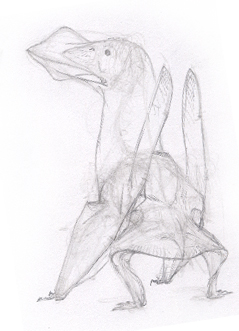
Anhanguera santanae

Like all large fliers, A. santanae is built to soar. With a wingspan of over four meters in length this pterosaur catches the thermals rising from the warm ocean water, using their lift to gain altitude while it uses the membranes stretched across its legs to steer and to stabilize itself. Upon spotting the glimmer of a shoal of fish or other small marine animals, the A. santanae swoops down, its head lowered, the triangular keel on its lower jaw beak angled into the water. Mouth open, tiny needle-like teeth bared to the water, the A. santane skims across the surface of the sea. As it snares a fish, the pterosaur bites down and snaps its head down, gaining another few fractions of a second to get a firm grip on the fish while the keel on its upper jaw cuts through the water, stabilizing the still air-born predator. An adjustment of wings and legs and the A. santane catches the thermals and rises again, now with its meal safely ensnared in its jaws.
Other sites containing pertinent information:
Dinodata Anhanguera
John Conway's wonderful Anhanguera skeletal reconstruction
Cool diagram of Anhaguera's membranes
® Daniel Bensen 2004
This image modified by Adobe Photoshop
Back to OPUS: Dinosaur